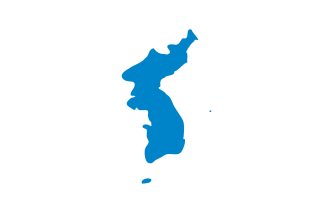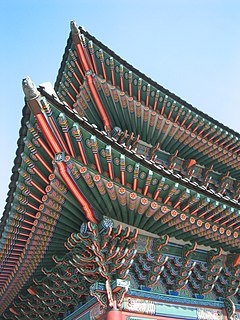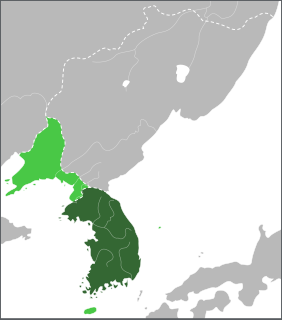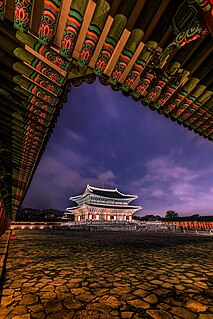
Korea is a peninsular region in East Asia. Since 1945, it has been divided between two countries at or near the 38th parallel, North Korea and South Korea. Korea consists of the Korean Peninsula, Jeju Island, and several minor islands near the peninsula. The peninsula is bordered by China to the northwest and Russia to the northeast. It is separated from Japan to the east by the Korea Strait and the Sea of Japan.

The Lower Paleolithic era in the Korean Peninsula and Manchuria began roughly half a million years ago. The earliest known Korean pottery dates to around 8000 BC, and the Neolithic period began after 6000 BC, followed by the Bronze Age by 2000 BC, and the Iron Age around 700 BC.

Baekje or Paekche, also called Nambuyeo, was a Korean kingdom located in southwestern Korea from 18 BC to 660 AD. It was one of the Three Kingdoms of Korea, together with Goguryeo and Silla.

The music of Korea refers to music from the Korean peninsula ranging from prehistoric times to the division of Korea into South and North in 1945. It includes court music, folk music, poetic songs, and religious music used in shamanistic and Buddhist traditions. Together, traditional Korean music is referred to as gugak, which literally means "national music."

Samhan or the Three Kingdoms of Korea refers to the three kingdoms of Goguryeo, Baekje, and Silla. Goguryeo was later known as Goryeo, from which the modern name Korea is derived. The Three Kingdoms period is defined as being from 57 BC to 668 AD.

The traditional culture of Korea is the shared cultural and historical heritage of Korea and southern Manchuria before the division of Korea in 1945. Manchuria refers to the ancient geographical and historical region in Northeast Asia, including countries like China and Russia. As one of the oldest continuous cultures in the world, Koreans have passed down their traditional narratives in a variety of ways.

Silla or Shilla was a Korean kingdom located on the southern and central parts of the Korean Peninsula. Silla, along with Baekje and Goguryeo, formed the Three Kingdoms of Korea.

Buyeo, Puyŏ or Fuyu, was an ancient kingdom that was centered in northern Manchuria in modern-day northeast China. It is sometimes considered a Korean kingdom, and had ties to the Yemaek people, who are considered to be the ancestors of modern Koreans. Buyeo is a major predecessor of the Korean kingdoms of Goguryeo and Baekje.

Clogs are a type of footwear made in part or completely from wood. Used worldwide, their forms can vary by culture, but often remained unchanged for centuries within a culture.

Unified Silla or Later Silla is the name often applied to the Korean kingdom of Silla, one of the Three Kingdoms of Korea, after it conquered Baekje and Goguryeo in the 7th century, unifying the central and southern regions of the Korean peninsula.

Zori, also rendered as zōri, are thonged Japanese sandals made of rice straw, cloth, lacquered wood, leather, rubber, or—most commonly and informally—synthetic materials. They are a slip-on descendant of the tied-on waraji sandal.

Geta (下駄) are traditional Japanese footwear resembling flip-flops. A kind of sandal, geta have a flat wooden base elevated with up to three "teeth", held on the foot with a fabric thong, which keeps the foot raised above the ground.

Waraji are light tie-on sandals, made from ropemaking fibers, that were the standard footwear of the common people in Japan.

Sandals are an open type of footwear, consisting of a sole held to the wearer's foot by straps going over the instep and around the ankle. Sandals can also have a heel. While the distinction between sandals and other types of footwear can sometimes be blurry, the common understanding is that a sandal leaves all or most of the foot exposed. People may choose to wear sandals for several reasons, among them comfort in warm weather, economy, and as a fashion choice.

Korean arts include traditions in calligraphy, music, painting and pottery, often marked by the use of natural forms, surface decoration and bold colors or sounds.

Korean architecture refers to an architectural style that developed over centuries in Korea. Throughout the history of Korea, various kingdoms and royal dynasties have developed a unique style of architecture with influences from Buddhism and Korean Confucianism.
Korean influence on Japanese culture refers to the impact of continental Asian influences transmitted through or originating in the Korean Peninsula on Japanese institutions, culture, language and society. Since the Korean Peninsula was the cultural bridge between Japan and China throughout much of East Asian history, these influences have been detected in a variety of aspects of Japanese culture, including technology, philosophy, art, and artistic techniques.
Gwisil Boksin was a military general of Baekje, one of the Three Kingdoms of Korea. He is remembered primarily as a leader of the Baekje Revival Movement to restore the kingdom after the capital fell in 660 to the Silla–Tang alliance.

The Baekje Historic Areas are a group of monuments located in three South Korean cities: Gongju, Buyeo, and Iksan. They relate to the last period of the Baekje Kingdom, representing the period from 475 to 660 CE, which was one of the three kingdoms that flourished from 18 BC to 660 AD. The property designated as a UNESCO World Heritage Site has eight archaeological sites. These are: The Gongsanseong fortress and the royal tombs at Songsan-ri, related to the capital city of Ungjin, now Gongju; the Busosanseong Fortress and Gwanbuk-ri administrative buildings, the Jeongnimsa Temple, the Neungsan-ri royal tombs, and the Naseong city wall in Sabi, now Buyeo; and the Wanggung-ri Palace and the Mireuksa Temple in Iksan, a subsidiary capital region of Sabi.
Imperial titles were used in various historical Korean states before the 14th century and at the turn of the 20th century. Early Korean states used "great king", "greatest king", and "holy king"; later Korean states used "emperor". Korean monarchs who used imperial titles had political and religious authority over a realm or domain. The Chinese concept of tianxia, pronounced "cheonha" in Korean, was variously adopted and adapted to Korean views of the world from period to period.

















